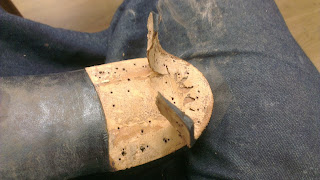If you are in London this weekend, we have our Open Studios at Cockpit Arts. We have some complimentary tickets so if you come, call us when you arrive and we will come and let you in - 02078130093
This week, we had an amazing series of emails from a blog reader in the Philippines. Some good news from there too which is great. Here is what he said.
I went to Europe for the first time over the summer and for the first time, I was introduced to a wide range of quality dress shoes not found in the Philippines. Since cost of these shoes were significant I did considerable research in what to buy, how to take care of them, and ultimately how it was made. I stumbled upon your blog and fell in love with craftsmanship and art, involved in something so useful as a shoe.
So much so that I started looking for places where I could learn the craft. I found a small factory in Marikina that I paid to let me work in their factory and ask help from their workers. I would show them certain blog posts and asked if they could teach me how to hand last, sew a welt, etc.. There I met wonderful people who before were shoemakers but had given up the trade. I quickly found out that most of Marikina, which had small workshops in every street corner, had almost given up making handmade shoes and were now importing their shoes.
Here I met Ading and Elsa, two shoemakers who used to make handmade shoes back in the 80's and we started Sapatero together. We wanted to see what would happen when you combine Filipino craftmanship coupled with world class materials. Your blog was a wonderful inspiration and a great starting point for us here in Sapatero. Thank you for your work.
And here are some pictures of them in their workshop And their work.
One question was where to get high quality calf skin in South East Asia. Can anyone help?
We wish Raymond and his fellow workers the very best of luck and feel proud that we had a small part to play in inspiring a new shoemaking business.
And on to toe plates. Here is how we do it.
First off, mark the position of your plates on both shoes. If they are metal ones, you have to do them to fit. Otherwise, you can make them any size you want.
Then cut along the line to the depth of your plate. But not through the stitches!
Cut away like this at an angle to reveal the cut better.
Cut away a space for the plate. If you are very organised, you can rebate this space before you stitch the sole on. I am not very organised.
Apply contact adhesive to both surfaces.
Glue on the plates and trim carefully. We like to put in tacks because they stay on longer and we like the retro look. Et voila! Toe plates.
Just a word of advice now to those of you who stick your grubby little fingers into the back of your shoes when you put them on. And also to those of you who kick them off again with the other foot. And especially to those who do both.
DON'T DO IT!
This is what happens. It makes the stiffener soft and the heel saggy. And it collapses the stiffener, both at the top and at the bottom. Big no nice!
And so we come to the end of another riveting post. We hope you enjoyed it and/or found it useful. We always welcome your comments and feedback. In fact, it's what makes doing this blog worthwhile.
Until next week, happy shoemaking!































































